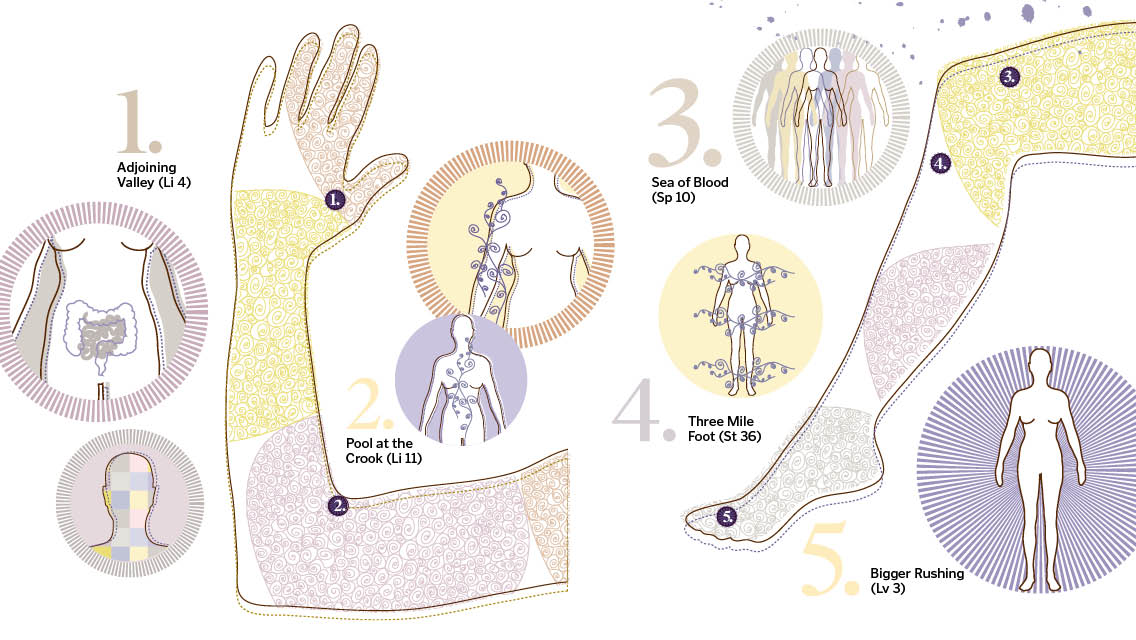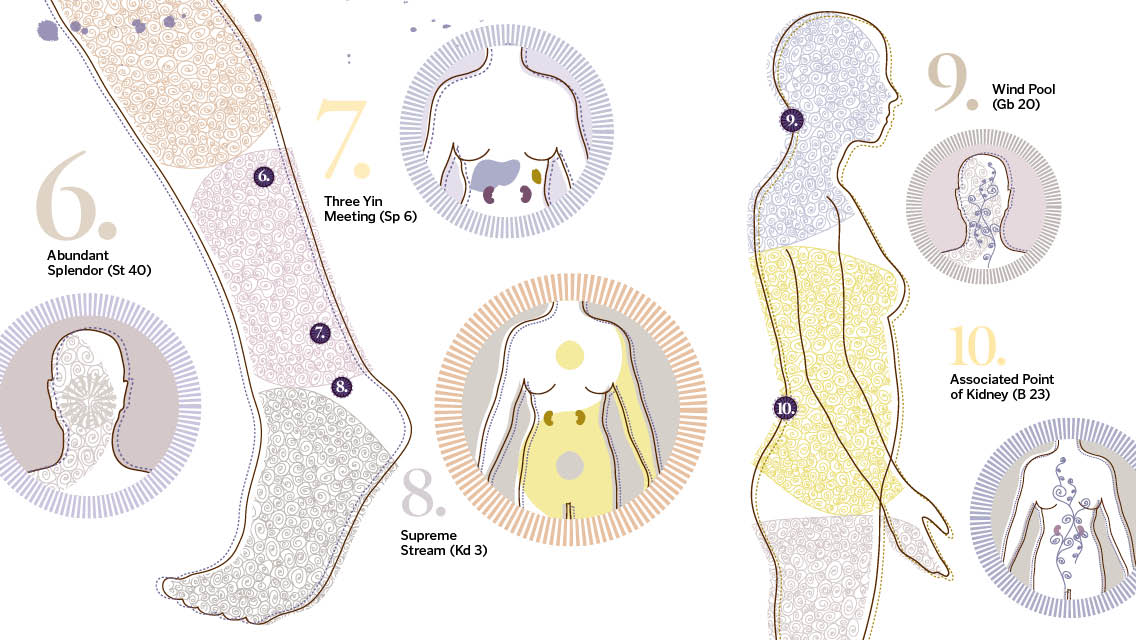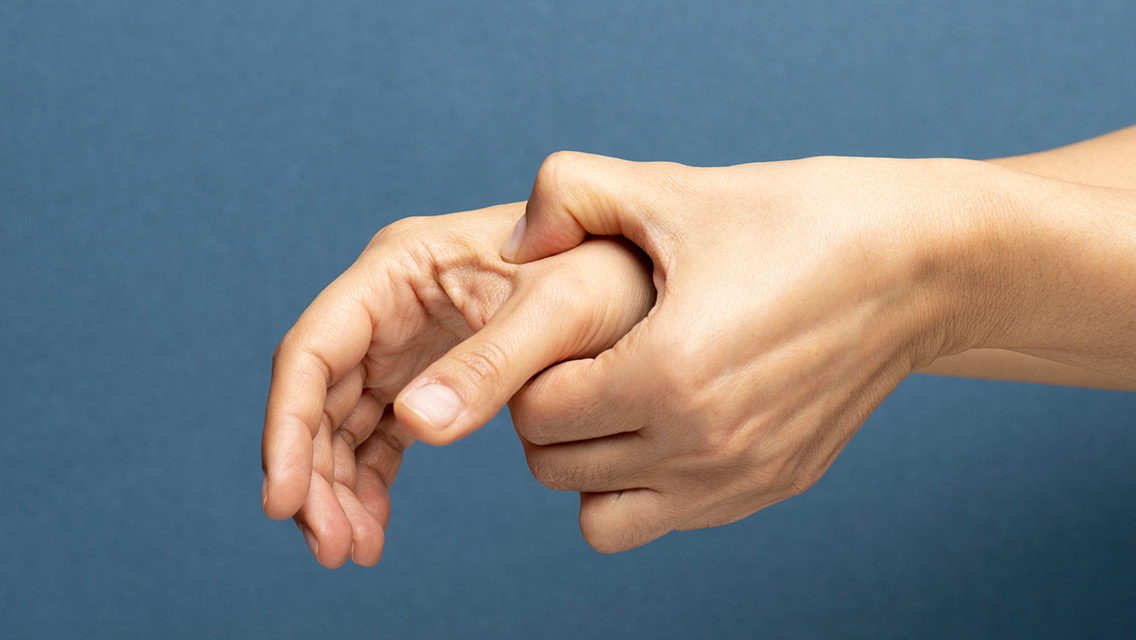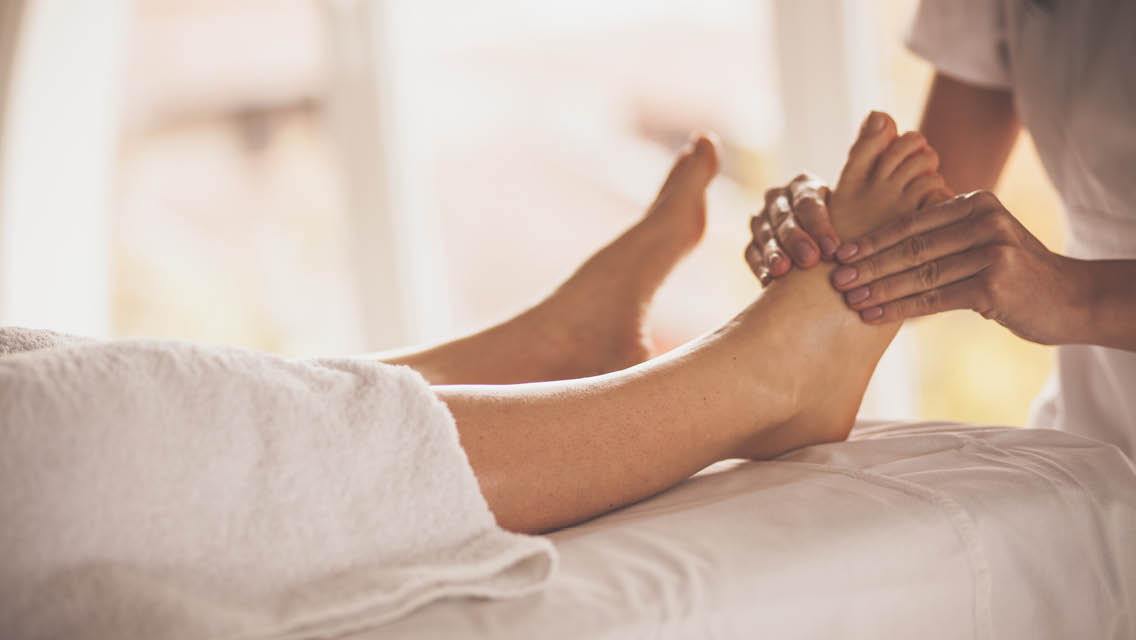Navigate to the pressure point you’re seeking:
If you bump your knee, stub your toe, or whack your elbow, your first impulse is to touch the spot that hurts. That instinct — the desire to soothe pain with touch — is the essence of acupressure.
Acupressure is the practice of applying precise pressure, usually with fingertips, to various points on the body with the goal of balancing life energy, called qi in Traditional Chinese Medicine or chi in the West. The points lie along channels of energy in the body called meridians. Envision the body as a house wired for electricity, but instead of cables, meridians carry the electricity. When the meridians are blocked or out of balance, pain arises.
Acupressure might sound wacky, especially for Americans taught to seek healing in pills and procedures. But acupressure is not a New Age contrivance. It’s been around for 5,000 years and is based on ancient understandings of the body as both a physical and energetic entity.
What Does Acupressure Do?
Acupressure unblocks meridians using gentle yet firm pressure on specific points along the energy lines, called acupoints. In response to the pressure, the brain oozes endorphins, chemicals that muffle pain signals and invite pleasurable feelings. In the absence of pain, muscles relax and blood flows more freely. As tension recedes, the body finds balance.
Acupressure isn’t just a remedy; it’s also a preventive measure. Strategically applied pressure enables the body to resist stressors and illness.
“Disease is the last stage of a process that begins with imbalance and disharmony on an energetic level,” says Jack Forem, author of numerous books on pressure-point therapy, including Healing with Pressure Point Therapy. “But when the body’s energy flows smoothly and harmoniously, it sustains life, nourishes the organs, and maintains health and vitality.
“Quantum physics shows us that solid matter, including our bodies, is the outermost shell of a multilayered energy body, that beneath the physical surface are levels of cells, molecules, atoms, and subatoms,” Forem says. “We also know that subtle levels are more powerful than surface levels. The theory beneath energy-based modalities is that practitioners impact the whole by manipulating the subtle.”
The body has hundreds of acupoints. Imagine them like electrical outlets. Each is a place where the underlying meridian’s electrical charge runs close to the surface and is easy to access. Typically, an acupoint lies in an indentation, like the hollow at the temples or the notch between the collarbones at the top of the sternum. In fact, the word “point” is a bit of a misnomer, says John Hickey, cofounder of the Santa Barbara College of Oriental Medicine. “The Chinese character for pressure point conveys more of a cave or an opening,” he says, explaining that “point” probably came into use later when acupuncture brought needles into the picture.
Acupoints are the same for both acupuncture and acupressure. If you were wielding a needle, you’d want to hit the bull’s eye, but acupressure is more forgiving.
“Being spot-on the point is helpful, but if you are close enough, you’ll be fine,” says David Bole, PhD, director of the Traditional Acupuncture Center, a holistic healthcare facility in Gainesville, Fla.
You can use pressure points for good or evil. Practitioners of some martial arts exploit the body’s most vulnerable pressure points by striking them during battle. Hitting certain points with force can knock a person out or make someone stop and gasp for air.
For healing purposes, practitioners apply pressure to points near an afflicted area. For instance, pressure to many points on the head is helpful for ailments of the mind, like anxiety.
Other times, the most useful points, called distal points, are on the opposite end of the meridian or opposite part of the body from the area of pain or discomfort. Stimulating these points opens the entire channel of energy.
“If a person comes to me with a migraine, I might end up working on his foot,” says Bole. “Every point has its own personality, its own use.”
Don’t expect the average medical doctor or insurance company to endorse acupressure anytime soon. The metrics of Western medicine — clinical trials — are dull tools for measuring energetic nuance. But that doesn’t mean it’s not effective, especially for people with tough-to-treat conditions such as fibromyalgia, chronic fatigue, and addiction recovery.
Acupressure is safe for almost everyone, and basic techniques are easy to learn. Whether you are looking for a basic tune-up or hoping for something more, give it a try.
You could spend years memorizing the location of the body’s hundreds of acupoints, but some are considered power players. Many lie at the crossroads of more than one meridian and, therefore, are believed to have widespread benefits across multiple organ systems. (Note: If you are pregnant, consult a medical expert before using acupressure, since some acupoints may cause the uterus to contract.)
Below is a list from Jack Forem’s Healing with Pressure Point Therapy. Each point has an assigned letter and number combination that corresponds to its location on the body (a standard referencing system used by professional acupressurists and acupuncturists), as well as a more poetic name, derived from its Chinese character and offering insight into the point’s location or benefit.
Top 10 Acupressure Points

Acupressure Point for Headache, Muscles, and Bowel Movements
1) Adjoining Valley (Li 4): Position your left hand palm down and lightly squeeze your thumb and fingers together. A fleshy mound pops up in the webbing between the base of the index finger and thumb. Eyeball this spot, relax your left hand, and using your right hand (thumb above, index finger below), press on this point (see number 1 in illustration above).
One of the most important points in acupressure, Li 4 relieves headaches, relaxes tense muscles, and encourages healthy bowel function.
Acupressure Point for Arm Pain and Digestion
2) Pool at the Crook (Li 11): As its name suggests, this point is in the crook of the elbow. Hold your left arm in front of you at a 90-degree angle, as if it was in a sling. Turn the left palm up. Place your right thumb at the outside end of the elbow crease (see number 2 in illustration above). Press firmly. Switch arms.
Use this point to relieve pain in the arm, elbow, or shoulder. Pressure here can also regulate the digestive tract.
Acupressure Points for Skin Problems
3) Sea of Blood (Sp 10): To find these two points, sit in a chair with your feet flat on the floor. Feel for a bulge in your thigh muscles about two thumb widths above the top edge of your knee. The bulge is on the top inside portion of the leg. Press on the points firmly with your thumbs or the knuckle of your middle finger (see number 3 in illustration above).
These points cleanse the blood and nourish the skin.
Acupressure Points for Energy
4) Three Mile Foot (St 36): This point is four finger widths below the lower edge of the kneecap and one finger width to the outside of the shinbone (see number 4 in illustration above). You’ll know you’ve got it if, when you flex your foot, the leg muscle (the tibialis anterior) moves under your fingers.
The point is often used by runners and hikers to squeeze out the extra three miles of energy the name implies. Put pressure on this point to revitalize the chi of the entire body.
Acupressure Points to Relieve Stress
5. Bigger Rushing (Lv 3): This point is on the top of the foot, making it easy to find. Place the tip of your index finger at the webbing between the big toe and second toe. Slide your finger up your foot about half an inch, until you feel an indentation (see number 5 in illustration above). That’s the point. If you can reach, do both feet at the same time. If not, do one and then the other.
This is the most powerful stress-relieving point on the body.

Acupressure Points for Sinus Congestion
6) Abundant Splendor (St 40): A bit hard to find, this point is worth the hunt. It lies on the outside of the leg, halfway between the anklebone and the center of the kneecap. Take a seat. Wrap your fingers around the back of the shin at the middle of the leg. Using your thumb, press into the shinbone (tibia), and then slide your thumb two inches or so off the bone toward the outside of the leg (see number 6 in second illustration above). Press firmly.
Applying pressure to this point reduces sinus congestion and mucus buildup.
Acupressure Points for Menstrual Cramps
7) Three Yin Meeting (Sp 6): The three meridians of the leg cross at this point on the inside of the leg above the anklebone. To find it, press your thumb into the center of your anklebone, then slide up the inner leg four finger widths. The point is just off the shinbone (tibia), toward the back of the leg (see number 7 in second illustration above).
Applying pressure to this point nourishes energy flow to the spleen, liver, and kidney meridians. It is also good for treating menstrual pain.
(For more about your monthly cycle, see “What Your Period Is Trying to Tell You”.)
Acupressure Points for Kidney Health
8) Supreme Stream (Kd 3): Find this point by putting your right thumb on the inside of the prominent bone in the left ankle. Next, let your thumb slide toward the Achilles’ tendon. The point is in the depression between the bone and the tendon (see number 8 in second illustration above).
This point is the best point on the body for nourishing the kidneys, which are the root of yin and yang energy in the body. Balancing these opposing energies is essential to staying healthy.
Acupressure Points for Migraines, Colds, and Neck Stiffness
9) Wind Pool (Gb 20): Corresponding with the gall bladder meridian, these two points are found along the ridge of the occipital bone. Place your thumbs on the base of your skull near the hairline. Slide your thumbs along the bony ridge of the base of your skull until each thumb is midway between the spine and the ear. The points lie there, between the two neck muscles that come together where the neck meets the skull (see number 9 in second illustration above).
Pressure to these points can ease tension headaches, migraines, colds, and neck stiffness.
(For more about migraine prevention, see “How to Prevent Migraines”.)
Acupressure Points to Stimulate the Kidney Meridian
10) Associated Point of Kidney (B 23): This pair of points lies on either side of the lower back just above the upper rim of the sacrum. The best way to apply firm pressure to these points is to lie on the floor with a tennis ball under you. Ideally, lie on two tennis balls inside a sock to stimulate both points at once (see number 10 in second illustration above). Position the pressure an inch and a half on either side of the spine.
This will stimulate the kidney meridian. The kidneys regulate the flow of water in the body, and their health is vital for maintaining overall balance.
4 Acupressure DIY Tips
The beauty of acupressure is that it is something you can do for yourself anytime and anywhere. Acupressure is not meant to be a substitute for medical treatment, especially for a serious condition, but it is worth exploring as a supplement to other treatments. And it’s always available in a pinch. Here are a few tips to keep in mind when giving yourself or someone else acupressure:
- Use your middle finger (with your index and ring fingers lending support on either side) to press into the point firmly for two to three minutes. In some instances, the location of the point makes it easier to use the thumb or even a knuckle.
- If you’re practicing on yourself, you may notice that some points are more sensitive than others. That’s normal. Adjust the pressure until it is strong but not painful. If you are doing it on someone else, ask how the pressure feels. Remember, pain halts the flow of energy.
- Apply slow, firm pressure on the point at a 90-degree angle.
- Apply and release pressure gradually to allow the tissues time to respond.
Download a PDF of this article in its entirety.
This article has been updated. It was originally published in the April 2014 issue of Experience Life.





This Post Has One Comment
Hello! Yes, all these points really work. Thanks for the detailed description. But, it turns out you can do acupressure on the ear for the lower back. Recently, I found a very interesting article ‘’4 Healing Acupressure Points for Low Back Pain’’ where the author Lugashok describes this kind of massage. In just 2 minutes a day, massaging the ear, you can anesthetize and heal the lower back. Read here https://bit.ly/3IMcODE . I highly recommend it.